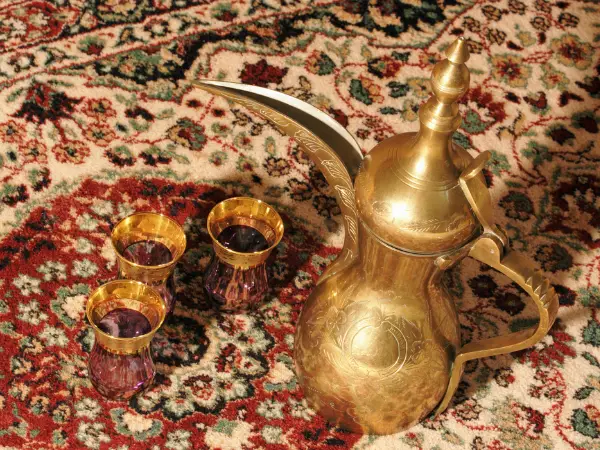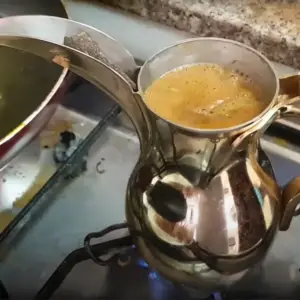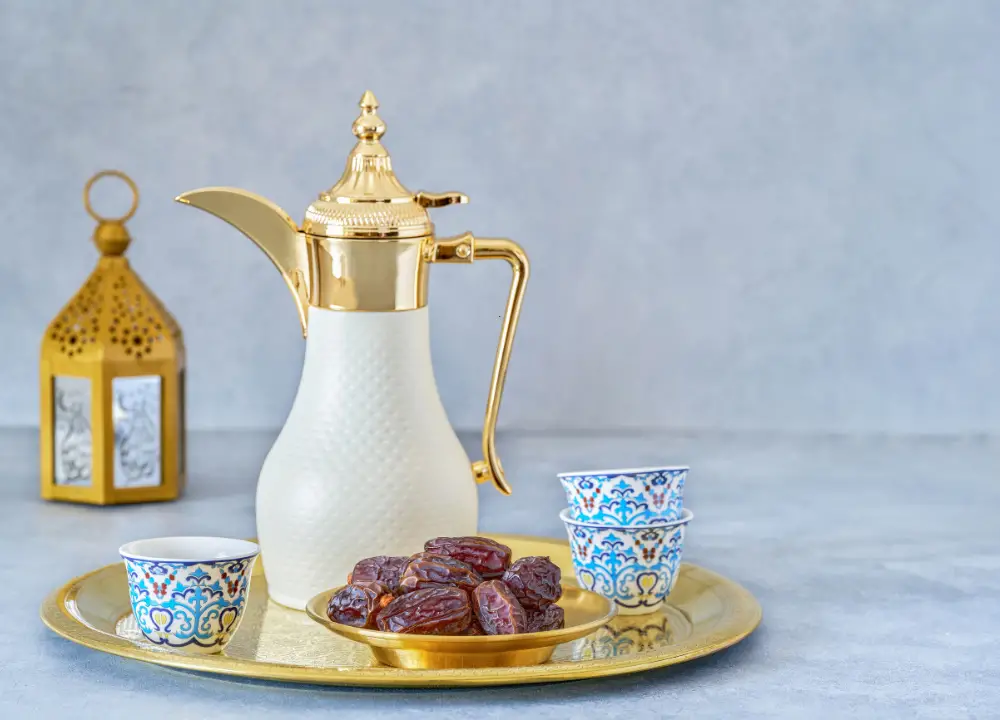Saudi coffee, known as “qahwa,” is often flavored with spices like cardamom and served with dates. This drink is not just enjoyed for its taste; it plays a crucial role in social gatherings.
Introduction To Saudi Arabian Coffee
Saudi Arabian coffee is more than a drink. It is a symbol of hospitality and culture. The rich history and unique recipes make it special. This guide explores the essence of Saudi Arabian coffee, its significance, and how to prepare it.
What Is Saudi Arabia Coffee?
Saudi Arabian coffee, known as Arabic coffee or Gahwa, is a traditional beverage. It is made from lightly roasted coffee beans, often flavored with spices. The preparation and serving of this coffee hold deep cultural importance.
Here are some key features of Saudi Arabian coffee:
- Light Roast: The beans are roasted lightly to preserve their natural flavors.
- Flavoring: Common spices include cardamom, saffron, and sometimes cloves.
- Serving Style: Coffee is served in small cups, often accompanied by dates.
- Social Aspect: Serving coffee is a sign of respect and hospitality.
The History Of Coffee In Saudi Arabia
The history of coffee in Saudi Arabia is rich and fascinating. It intertwines with the culture, social practices, and daily life of the people.
The Origins Of Coffee In The Arabian Peninsula
The story of coffee began in the Arabian Peninsula. Historians trace its origins back to the 15th century in Yemen. Here are some key points about the beginnings of coffee:
- Yemen’s Role: Yemen was the first place to cultivate coffee. The beans were grown in the highlands.
- Trade Routes: Coffee traveled through trade routes to other regions. It spread to Persia and later to Europe.
- Early Preparation: Coffee was initially boiled with spices. The method of preparation varied by region.
In the 16th century, coffee houses called qahveh khaneh emerged. These places became social hubs for conversation and entertainment. They offered a space for discussing literature and politics.
Here’s a table summarizing the early history of coffee:
| Year | Event |
|---|---|
| 15th Century | Coffee cultivation begins in Yemen. |
| 16th Century | First coffee houses open in the region. |
| 17th Century | Coffee spreads to Europe. |
The Role Of Coffee In Early Saudi Culture
In early Saudi culture, coffee was more than a drink. It played a vital role in social interactions and rituals. Hosting guests with coffee was a sign of respect and hospitality.
Bedouins, the nomadic tribes of Arabia, had their own coffee traditions. They prepared coffee using simple methods over an open fire. The coffee was often flavored with cardamom or saffron.
Key aspects of coffee’s role in early Saudi culture include:
- Social Gatherings: Coffee was central to gatherings. People shared stories and built bonds.
- Rituals: Coffee was part of celebrations, weddings, and important events.
- Symbol of Friendship: Offering coffee symbolized friendship and goodwill.
Every cup of coffee served was a gesture of hospitality. It created a warm and welcoming atmosphere. This tradition continues today, reflecting the deep roots of coffee in Saudi culture.

The Cultural Significance Of Coffee In Saudi Society
Coffee holds a special place in Saudi Arabia. It is more than just a drink; it is a part of the culture and traditions. The way coffee is prepared and served reflects Saudi hospitality.
Coffee And Saudi Hospitality
In Saudi Arabia, coffee symbolizes hospitality. Serving coffee is a sign of respect and friendship. Guests are welcomed with a warm cup of coffee, often spiced with cardamom. This tradition goes back centuries. It shows how much the host values their guest.
Here are some key aspects of coffee and hospitality in Saudi culture:
- Symbol of Respect: Offering coffee is a gesture of goodwill.
- Unique Serving Style: Coffee is served in small cups, often without handles.
- Traditional Ritual: The host pours coffee from a special pot called a ‘dallah.’
- Accompanying Snacks: Dates or sweets are often served alongside coffee.
The process of serving coffee is important. It is not just about the drink. It is about creating a connection. The host pours the coffee with care, showing their hospitality. Guests may drink three cups. It is a way to show they appreciate the offer. After the third cup, guests may shake their cup to signal they have finished.
The Role Of Coffee In Social Gatherings And Ceremonies
Coffee is central to social gatherings in Saudi Arabia. It is present at weddings, funerals, and other important events. People come together to share stories and enjoy each other’s company over coffee.
Here are some ways coffee is involved in social events:
- Weddings: Coffee is served to celebrate the union of two families.
- Funerals: It is offered to guests as a sign of comfort.
- Family Gatherings: Coffee helps strengthen family bonds.
- Business Meetings: Sharing coffee can build trust in professional settings.
Special occasions often include unique coffee blends. For example, during Ramadan, families prepare special coffee to break their fast. This shows how coffee connects people, no matter the occasion.
The Influence Of Coffee On Saudi Art And Literature
Many poets and writers have used coffee to express their thoughts and feelings. Its presence in their work highlights the drink’s importance in daily life.
Coffee As A Symbol In Poetry And Prose
In Saudi literature, coffee often symbolizes warmth, friendship, and community. It appears in poems and stories as a metaphor for connection between people. Coffee gatherings, known as majlis, are crucial social events. They are spaces where stories are shared and relationships are built.
Poets express their love for coffee through vivid imagery. They describe the rich aroma and inviting warmth of a freshly brewed cup. Coffee represents more than just flavor; it evokes feelings of nostalgia and longing.
- Warmth: Coffee brings people together, fostering closeness.
- Connection: It symbolizes friendships and social bonds.
- Nostalgia: Coffee reminds people of cherished moments.
Saudi poetry often features coffee in various forms. The drink appears in classical and modern works, showcasing its enduring significance. Below is a table showing famous Saudi poets who reference coffee in their works:
| Poet | Work | Theme |
|---|---|---|
| Adnan al-Sayegh | “Morning Coffee” | Hope and Renewal |
| Nizar Qabbani | “The Taste of Coffee” | Love and Longing |
| Fahd Al-Ahmad | “Coffee and Memories” | Nostalgia |
Through these works, coffee becomes a canvas for expressing human emotions. It connects people across generations. The art and literature of Saudi Arabia continue to celebrate coffee, making it a vital part of the cultural landscape.
Traditional Saudi Coffee Preparation
Saudi Arabia has a rich coffee culture. The preparation of traditional coffee is an art. It reflects the country’s history and social customs. Saudi coffee, known as “Gahwa,” is unique in flavor and presentation. This section explores how to prepare this cherished drink.

Saudi Arabian Coffee Recipe
Equipment
- Coffee grinder
- Medium-sized pot
- Measuring Spoons
- Strainer
- Coffee warmer or thermos
Ingredients
- 1 cup lightly roasted coffee beans
- ½ cup cardamom pods
- 2 pcs cloves
Instructions
- Start with high-quality coffee beans. Look for Arabica beans for the best flavor. You will need about 2 tablespoons of coffee beans for every cup of water. Follow these steps:Measure the coffee beans.Use a coffee grinder. A manual grinder works well.Grind the beans until they are coarse. Aim for a texture similar to sea salt.Grinding the beans fresh is key. It brings out the natural oils and flavors. Store any extra ground coffee in an airtight container to keep it fresh.

- Cardamom adds a unique flavor to Saudi coffee. You will need about 2-3 cardamom pods for every cup of coffee. Here’s how to prepare them:Crack the cardamom pods open with the side of a knife.Remove the seeds inside.Place the seeds in the grinder with the coffee beans. Grind until fine.Cardamom is fragrant and spicy. It complements the coffee well. You can adjust the amount based on your taste. More cardamom means a stronger flavor.

- Now it’s time to combine your ingredients. You will need:Ground coffee: 2 tablespoonsGround cardamom: 1 teaspoonWater: 1 cupFollow these steps to cook the coffee:Boil the water in a pot.Add the ground coffee and cardamom to the boiling water.Reduce the heat and let it simmer for 10 minutes.Stir occasionally. This helps blend the flavors. You will notice a strong aroma filling the kitchen. The coffee will darken as it cooks. Taste it to check the strength. Adjust the brewing time if needed.

- Once the coffee is ready, it’s time to strain and serve. Follow these steps:Remove the pot from the heat.Use a fine mesh strainer or a coffee filter to strain the coffee.Pour the coffee into small cups.Traditionally, Saudi coffee is served in small cups without handles. You can enjoy it plain or with dates. The sweetness of dates complements the coffee's bitterness. Serve hot for the best experience.Enjoy your homemade Saudi coffee. Share it with friends and family. It’s a perfect way to connect over a warm beverage.

Tips For The Perfect Cup
| Tip | Description |
|---|---|
| Use Fresh Beans | Freshly roasted beans enhance the flavor. |
| Control the Heat | Too much heat can burn the coffee. Keep it medium. |
| Adjust Cardamom | Use less or more cardamom based on taste preference. |

